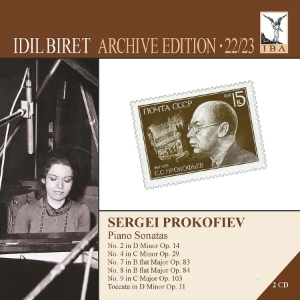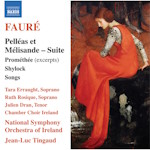
Sergei Prokofiev (1891-1953)
Piano Sonatas
Idil Biret (piano)
rec. 1960-76
Idil Biret Archive Edition 22/23
IBA 8.571429-30 [2 CDs: 132]
If there is one thing that the invaluable Idil Biret Archive Edition has taught me in the past fifteen years, it’s never to underestimate the breadth of her repertoire and the quality and quantity of her little known or unreleased recordings. Here we have 2 CDs of (mostly) Prokofiev Piano Sonatas. Before the advent of the Archive Edition, all the solo Prokofiev we had from her was that released on LPs in the 1960s and 70s: the Piano Sonata No. 7 recorded for Véga in 1961, and the Piano Sonata No. 2 recorded for Finnadar in 1976 (released 1977), both previously rereleased as part of the Archive Edition (No. 7 on Vol. 14: IBA 8.571296, No. 2 on Vol. 2: IBA 8.571275). It turned out though that another recording of No. 7 was made in 1977 at the same Finnadar sessions as No. 2 and not released at the time, but included in Vol. 2 of the Archive Edition. However, the compilers of this latest release have now unearthed new radio recordings of the Sonatas Nos. 4, 8 and 9, plus the Op. 11 Toccata. The discs in this Volume include the previously released recordings I have mentioned as well as the new ones in almost chronological order of recording, so all Biret’s known (for now!) solo Prokofiev can be found in one place. One other characteristic of note is that with the exception of the 1961 No. 7, all of the performances were made in a single take.
Things get off to a really exciting start with Biret’s incendiary performance of the Toccata. This was the final piece in her very first recital in Russia, in the Tchaikovsky Hall, Moscow in 1960. Her invitation to tour Russia came as a result of the influence of Emil Gilels who had heard Biret play at the home of Nadia Boulanger in Paris in the late 1950s. Many years later another great Russian pianist, Viktoria Postnikova, told Biret: “I will never forget your recital…in 1960. The audience went just crazy.” We are lucky to be able to hear why because of this newly discovered recording from the radio archives of the Soviet Union. It’s thrilling in its impetuosity and daring and Biret’s supreme technical command, which slips only slightly in the pretty impossible final bars. I would have been on my feet for sure. The piano sound is not bad at all.
Next comes the only conventional studio recording, the Sonata No. 7, made for Véga in Paris in 1961 and as I mentioned above, already previously reissued in the Archive Edition. This is the middle work of the three so-called ‘War Sonatas’. Biret captures very well indeed the profound disquiet of the opening movement and the Andante caloroso has, appropriately, given that marking, real warmth of tone and generosity. Her playing of the final movement Precipitato is a triumph. She makes light of the slightly awkward 7/8 rhythms and leans into the blues harmonies whilst proceeding at an exhilarating pace. My only disappointment is in the sound. For a studio recording of this vintage the acoustic is rather boxy.
The chronology moves on to Prokofiev’s penultimate Sonata, No. 9, composed in 1947. The performance was recorded for (I assume) Saarländischer Rundfunk in Saarbrücken in 1964. It sounds as if it was a live performance broadcast from a studio without an audience (as do the Turkish and Swiss radio recordings on the disc). It’s really one of the best performances of this Sonata I have heard, with excellent sound. Biret clearly did not need an audience to raise her performance levels. Her attack at the start of the second movement Allegro Strepitoso and again in the last movement Allegro Con Brio is breathtaking but there is equally supreme clarity in the polyphonic writing which pervades the Sonata and a palpable contemplative calm and restraint in the third movement Andante.
Slightly out of sequence (presumably for reasons of CD length) comes the Sonata No. 4 in a performance for Turkish Radio in Ankara 1973. I always struggle a bit with the rather dismal atmosphere of the first one and a half movements of this Sonata. Prokofiev wrote it in 1917 in the aftermath of the suicide of one of his closest friends and this really does seem to be reflected in the hesitant, diffident first half. For her, Biret seems very restrained throughout the piece, and doesn’t seem to want to make the most even of the rather determinedly jolly final movement. The recording is also by far the worst sonically on the disc, which doesn’t help lift the listener.
The start of Disc 2 jumps back a couple of years to a 1971 radio performance of the other ‘War Sonata’ here, No. 8, made for (again I assume) SR DRS in Zurich. I’ve written a lot already about Biret’s drive, fire and virtuosity in these performances but here what stands out is her approach to the Andante sognando middle movement. She captures perfectly the outer layer of ingenuousness cast by Prokofiev, whilst at the same time hinting at something rather more disturbing under the surface. It’s tremendously sensitive and thoughtful playing.
The Sonata No. 2 which follows is from recording sessions made by the rather short lived Finnadar Records in 1976 (and, as I mentioned above, already rereleased in the Archive Edition). The label was founded as a subsidiary of Atlantic and run by the innovative İlhan Mimaroğlu. His stated goal was to offer to the public primarily “recordings of contemporary compositions, with a view to also offer to the public performers who should be better known, among them Turkish pianist Idil Biret”. Biret indeed went on to make a series of recordings for Finnadar in the 1970s including recordings of Boulez, Berg, Webern as well as earlier classical repertoire. This recording of the Sonata No. 2 came on the second side of an LP which started with two Chopin Mazurkas and Scriabin’s Sonata No. 10. It’s notable because it was one of the first records in a 1970s revival of the ‘direct-to-disc’ recording process, essentially a return to the way records were made in the first half of the twentieth century, but with better technology. Magnetic tape, which had become the norm, was bypassed and audio was directly recorded onto analogue disc masters. So, for the performer, this means the performance has to be a single take, with obviously no scope for redoing parts and patching them in as with tape. The net result it was claimed (in the original liner notes for the album) would be a record which would “delight audiophiles with its big, lifelike piano sound.”
Well, after that build up I have to say that whilst perfectly acceptable, the piano sound didn’t leap out at me. I did however very much enjoy Biret’s performance of this quintessentially neoclassical sonata. Her control of register, so crucial to this piece, is a delight throughout and she makes what sometimes feel like a set of slightly miscellaneous movements cohere wonderfully. The Scherzo second movement for example, which Prokofiev reused from an earlier piece, in her performance comes over as an entirely logical prefigurement of the final movement’s restlessness whereas it can sometimes sound as if the composer dropped in a quick Étude to keep the performer on their toes.
The second performance of the Sonata No. 7 was made at the same sessions as the Sonata No. 2, also direct-to-disc, but not released on LP at the time and as noted above, already included in the Archive Edition. It provides an interesting contrast to the 1961 performance. It’s very slightly slower overall but the key contrast for me is that Biret seems more restrained, more meditative throughout, altogether more subtle. It’s facile to say this is because she was a little older and wiser, but I do very much get the sense of Biret’s growing appreciation that there is great sensitivity and anguish in this piece and that a more interesting performance – as here – would place less emphasis on the formidable technical challenges that her younger self in 1961 makes such light work of.
This has been a fascinating set of performances to discover, although for most of the sonatas neither the performances nor the piano sound would quite make me put them forward as a first choice. Mine remain Alexander Melnikov in his cycle for Harmonia Mundi for Nos. 2 (HMC902202) and 4 (HMM902203) and Steven Osborne on Hyperion for Nos. 7 and 8 (CDA68298). However, I do very much admire Biret’s performance of No. 9, and it sounds excellent. If in the end I still prefer Richter (on Alto ALC1485) in this piece, it is a close-run thing. In any event, I would wholeheartedly recommend this set as one which anyone who is interested in these endlessly absorbing and inventive works should explore.
Just a quick word on the documentation. I think the best way to describe it is as tangential. It’s all interesting, but more anecdotal than analytical, and some hard facts are lacking which I have had to research and/or make an educated guess at. In particular I wanted more information on the provenance and context of the three newly discovered radio recordings. I do understand that there won’t be a huge budget sitting behind this laudable project and booklets can’t be lavish, but in future I for one would welcome a bit more basic detail.
Dominic Hartley
Buying this recording via a link below generates revenue for MWI, which helps the site remain free



Contents
Toccata Op. 11 rec. 1960
Piano Sonata No. 7 Op. 83 rec. 1961
Piano Sonata No. 9 Op. 103 rec. 1964
Piano Sonata No. 4 Op. 29 rec. 1973
Piano Sonata No. 8 Op. 84 rec. 1971
Piano Sonata No. 2 Op. 14 rec. 1976
Piano Sonata No. 7 Op. 83 rec. 1976
Recording details
rec. 1960, Tchaikovsky Hall, Moscow; 1961, Véga Studios, Paris; 1964, Saarbrücken; 1971, Zürich; 1973, Ankara; 1976, RCA recording studios, Studio A, New York

















